Yesterday you saw how our board and batten project came out for the Pinterest Challenge, so today we’re back with the full tutorial shebang. And hold onto your safety goggles, it’s 2,000 words long. But don’t let all the words fool you, we’d say that this was one of the biggest bang-for-you-buck / most fool-proof ways to make an easy upgrade that we’ve encountered in a while. Wow, just realized I’m five sentences into this and I’ve already said “bang” twice. Not sure if that’s a good sign or what…
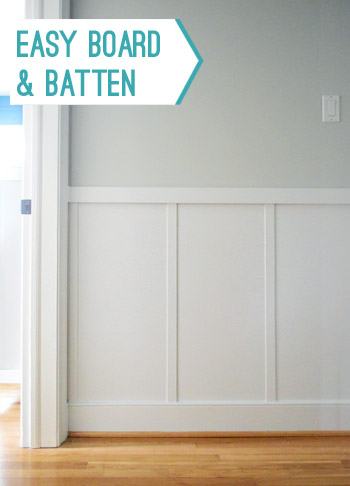
We had long known that adding some sort of molding feature to our hallway was in our future… and now we’re just kicking ourselves for waiting so long. It cost us a mere $57 for the materials (we did buy a tool on top of that, but we’ll get to that in a second) and it only took a few hour-or-two-long work periods over the course of 6 days (including some break days for paint-curing) to finally bring some oomph to our boring hall. So anyone who’s looking to tackle this on nights and weekends could hopefully do it within a week since each step only took a few hours and could be spaced out across each evening.
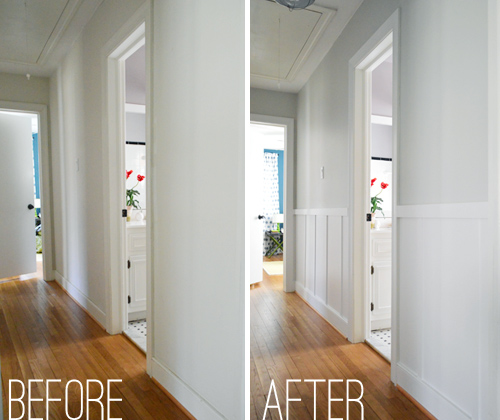
Planning Our Board & Batten
We were inspired by a few other tutorials – like Ana’s, Kate’s, Sarah’s, and Emily’s – and took pieces and parts of each to figure out what worked best for us. So our tutorial below may not be exactly what your space needs, but between the lot of us there should be a fitting solution in there! Let’s just say that we learned that there are many different ways that you can approach board and batten, so a lot is about personal preference, what suits your home, etc.

As for our approach, there are a few things to note upfront:
- We did not add any “board” to the wall – i.e. large flat panels. Since our walls are smooth (not textured) we just used the existing drywall as the backdrop for our vertical battens. Once everything was painted it all looked seamless and gleaming, just like a board would have looked. But if you have textured walls, check out Kate’s tutorial above.
- We used our existing baseboards. Why? Because it was easier – and you know we love to use what we have. Simply by choosing battens that were thinner than our baseboards, we could keep them in place and work with them (saving us time and money). But if you can’t or don’t want to take this approach, both Ana and Kate’s tutorials above talk about replacing the baseboard.
Oh, and if you’re not the word-reading type we made two videos of the process for you (one for the building portion and one for the finishing). So here’s how it all went down when it came to installing the rails and battens (including tips for how to keep the boards level, how to space them out, how to keep them from bowing too far from the walls, etc).
And here’s how we finished everything (including how we filled the nail holes, how I cut in without taping off, and a bunch of other stuff that we shoved in there):
And fret not if you can’t watch the videos (if, say, you’re at work) – we broke down all the steps with photos and descriptions right here (note: watching them later if you’re planning to tackle this might simplify things a lot – I always think videos make things less intimidating).
Measuring & Shopping For Materials
To start, we measured the space and planned our materials. My graph-paper sketch was probably overkill, but it made me feel better. It helped us plan how many boards we needed for the top rail and ledge, as well as count how many battens (the vertical strips) we might need.
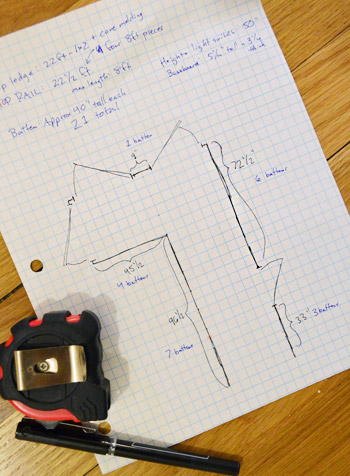
Next up was a supply run. We had most of what we needed on hand, so the only four items that we ended up purchasing are pictured below (the nail gun being a belated birthday gift from my sweet wife who was just waiting for me to pick out the one I wanted). Update: The nail gun shown below is no longer sold, but we’ve switched over to using this compressor-less nail gun these days anyways.

Tools & Supplies Needed
Here’s a full list of supplies & materials that we used (many of which we had on hand, along with the things we purchased above):
- Pneumatic brad nail gun
- Pre-primed lattice strips (our came in 12ft lengths, so I cut them down in store for easier transport)
- 1 x 3″ pine boards (for top rail)
- 1 x 2″ pine boards (for top ledge)
- Measuring tape
- Laser level (optional)
- Level
- Stud finder
- Miter saw (you can also use another saw for cutting wood, or even have them pre-cut in the store)
- Spackle, joint compound, or wood filler (for filling nail holes)
- Paintable white caulk meant for moldings & a caulk gun
- Sandpaper and/or palm sander
- Primer
- White paint (we used an extra durable cabinet-type paint in a satin finish)
- Paint brush, roller, and other painting supplies
*Buy your wood around a week before you start the project and just let it sit in your house (this is called “acclimating” the wood) to avoid any cracks caused by expansion or contraction, which happens if it’s not acclimated when it’s installed.
Installing The Top Rail
We opted to use 1 x 3″ pine boards for the top rails, which we wanted to attach first (after their acclimation period). So I cut them with my miter saw to fit snugly along each stretch of wall. If you have exact measurements for your space you can even get them pre-cut for you at Home Depot, so don’t let the use of a saw scare you off from this project.
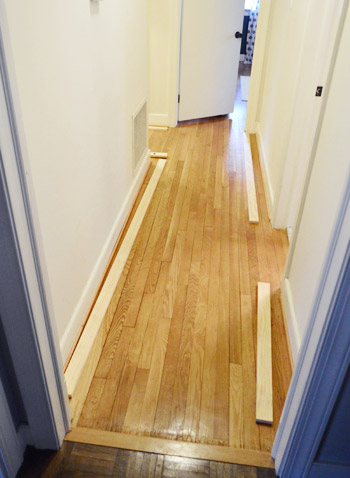
Before attaching them to the wall, we had to do a few things – like deciding the height of our board and batten. We first assumed “the higher the better!” and held it just under our light switches and thermostat. But after stepping back, we realized the high placement was just making our eight foot ceilings look lower than they already are.
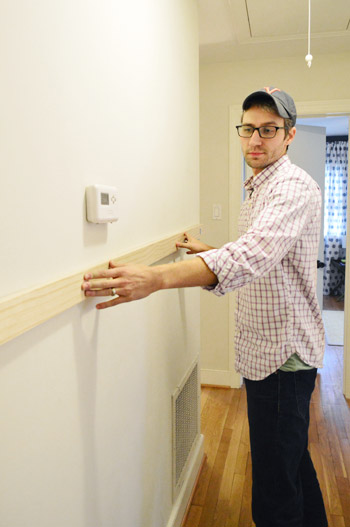
So, as you’ll see, we later landed on a more traditional height of 40″ off the floor, which is a lot closer to the “traditional range.” But again, many aspects of installing board and batten are just a personal preference thing, so go with whatever you think looks best for your space. I’m sure rooms with tall ceilings or ornate crown molding might look awesome with higher board and batten (as well as mudrooms and other entryway areas, etc).
Since floors and baseboards aren’t always level, we relied on this cheap laser level that I picked up a while ago to mark the 40″ line on a few spots along each wall. Those marks created a guide for us when holding our 1 x 3″ board in place.
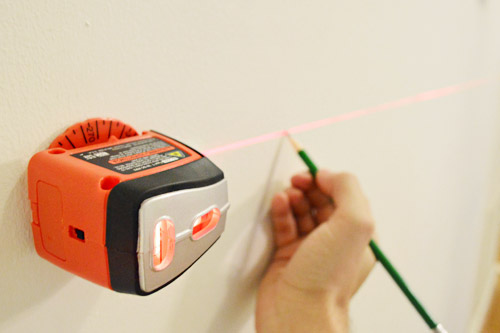
And since nails are always more secure when they go into studs, we also broke out our stud finder to mark each to-be-nailed spot along the wall. Obviously just remember to make your marks low enough that they won’t be covered when you hold up your top rail piece.
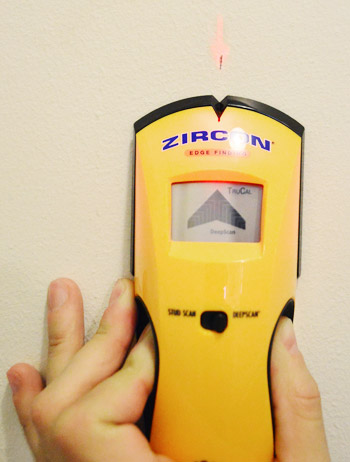
Next up was nailing the rails into place with my new pneumatic (i.e. air compressor powered) brad nail gun (the one photographed has been discontinued, but we switched to using this air-less nail gun anyways). This was my first time ever using one and it intimidated me the first few times, but now I’m in love with it (not as much as Sherry, who says she wants to marry it). I’ll write a separate post about it later, but let’s just say it was the saving grace of this project. It probably would’ve taken us three or four times as long to complete the construction portion of this project without it. We bought a pretty basic, but well-reviewed Craftsman model (here’s an affiliate link to it for ya).
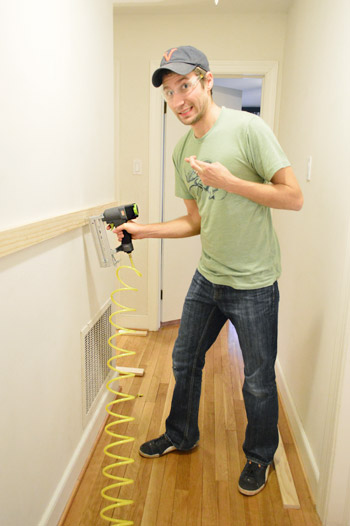
So here are all of the top rails in place. We opted not to glue them to the wall in addition to nailing them into studs simply because if we ever decide to remove or replace this, we don’t want to rip off chunks of drywall in the process. The good news is that the boards are so light – especially all of the vertical lattice pieces – that nails shot into studs with a nail gun are supremely secure… especially with the caulking that we did around any cracks to hold them even more firmly.
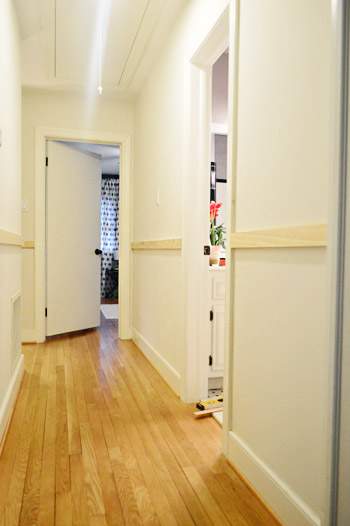
But even if you opted to glue things on top of nailing them, it wouldn’t add much time or cost to the project (a tube of Liquid Nails is just a few bucks). Speaking of time, if you subtract the time it took us to set up and figure out the nail gun, I’d say the process of measuring / cutting / nailing these took us about an hour.
Adding The Vertical Battens
We used lattice strips at Sarah and Emily’s suggestion because they were cheap (66 cents per foot!) and they didn’t stick out past our existing baseboard. Had we used 1 x 2″ boards like some folks do, it would’ve hung over our baseboards. We could’ve replaced our baseboards too, but then they would’ve stuck out past the trim around the four (count ’em four!) doors in our hallway. So yes, chunkier battens could be nice in less narrow spaces (we didn’t want ours to jut out too far and close things in) but in our case we actually thought the lattice + rail setup was ideal and we like the dimensional-but-not-crazy-thick result.
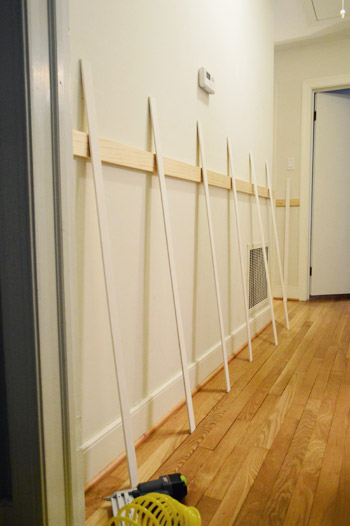
We chose to space our battens at 16″ intervals because our studs are 16″ apart and this meant that more nails would go into studs, not just into drywall. Plus, when we held up a few spacing options it looked pretty darn good (seriously, half of this project is just deciding what looks best and going with it). To make our lives easy, we used a scrap piece of 1 x 3″ board to make a spacer (a 14.5″ spacer kept the lattice 16″ apart from center to center).
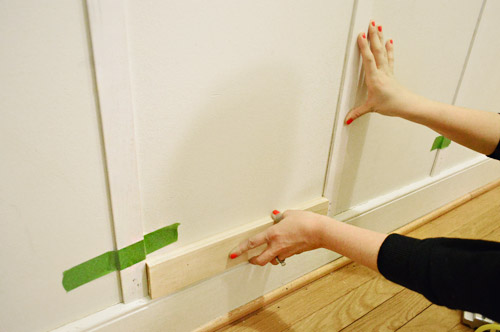
The lattice was light enough that tape held it to the wall while we used a level to make sure each batten was perfectly vertical. Then Sherry went back with the nail gun and secured them in place. Is it wrong to say that watching my lady concentrate so hard while wielding a power tool got me a little hot and bothered?
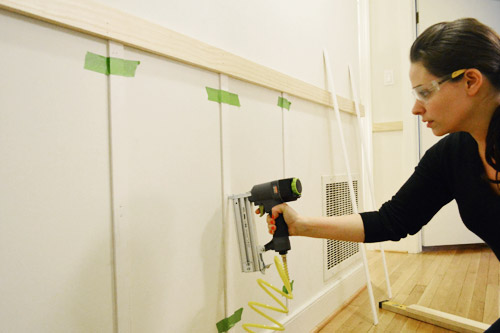
About an hour-ish later, all of the battens were cut to size and nailed into place.
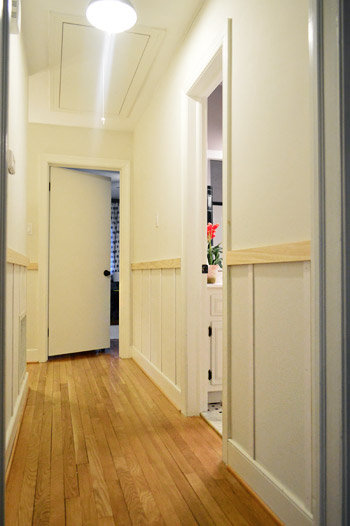
Since we wanted the batten on the facing walls to line up (and that’s where the studs were, which added stability), the placement was pretty easy to determine. But if you were tackling this and not every batten could end up in a stud to accomplish a balanced look, I’d go with balanced placement over hitting every stud (they’re seriously as heavy as a paint stirrer, so they’ll likely hold up fine either way).
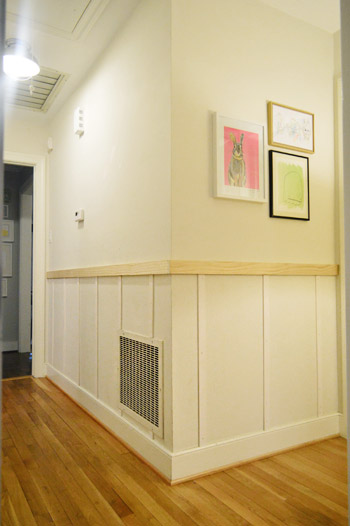
At around this stage of the project, Clara saw it for the first time – and here’s her reaction word for word: “Wow! It’s beautiful! Did a man come while I was sleeping and bring that?” Is that kid hilarious or what? She totally didn’t give us credit for it. We think it’s because that morning the heating guy came with an oil delivery for us, so she remembered a man coming to help with something and assumed he came back to fix up the hallway for us. Naturally.
Lots of the tutorials we saw included adding a ledge along the top to sort of beef things up or create a spot to lean art or other items. We bought some 1 x 2″ pine for this purpose but as soon as we held it in place we realized we didn’t really like it. Since it wasn’t going to be a functional ledge for us, it basically just narrowed the hallway more and created a few hazardous little corners for tiny heads to walk into. So we scrapped the idea, returned the wood, and enjoyed calling the construction phase: COMPLETE.

Prepare For Painting
The next day we started to prep the space for painting by filling nail holes and caulking gaps. At the recommendation of some of you guys, we went with spackle over wood putty (we hear joint compound works too) since it’s said to be easier to work with and holds up better over time. It certainly went on easier than wood filler so assuming it keeps looking as good as it looks right now, we’re completely sold on that approach for filling nail holes after your rails and battens are hung.
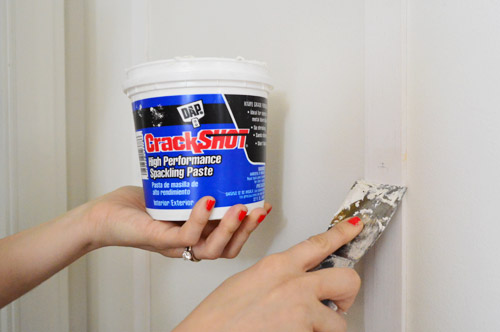
After all of the nail holes were spackled (not a fast process, but not too bad – maybe it took an hour total?) we used paintable white caulk to fill some of the gaps between our boards and the wall. Since our old house doesn’t have perfectly flat walls, this was a necessary step to keep the project looking nice and polished in the end. We didn’t do every edge, just the ones that needed it (across the top rail and a few places along the battens). I’d say the caulking step added another hour of work in case you’re wondering. Oh and definitely watch the finishing video in this post for more details about exactly what caulk we used, how I smoothed it, etc.
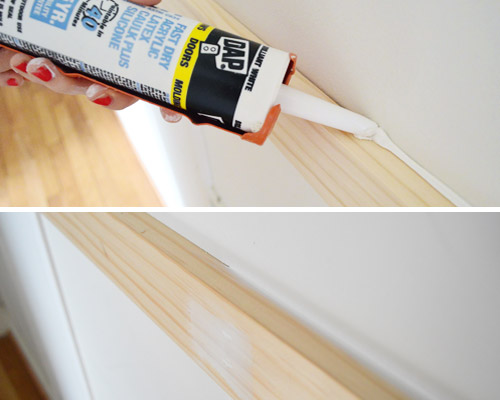
Later that day we broke out the palm sander to get rid of any excess spackle around the nail holes.
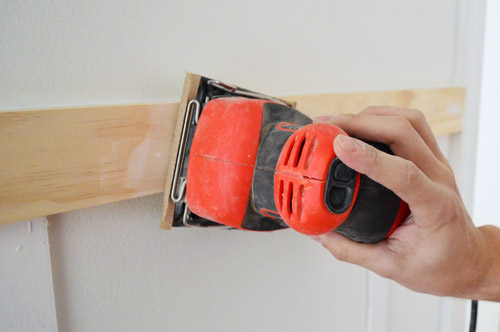
Prime & Paint
After that, the rails and battens were ready for primer. We already had Kilz Premium (which is a stainblocking primer) on hand, so we used a brush and a small foam roller to put one coat of primer on each piece of wood to prevent any bleed-through in the wood down the road (always a worthwhile “insurance” step). And we went over the battens too, just to be safe (even though they came pre-primed). Here’s the whole thing primed and almost ready for paint. Just had to let the primer dry.
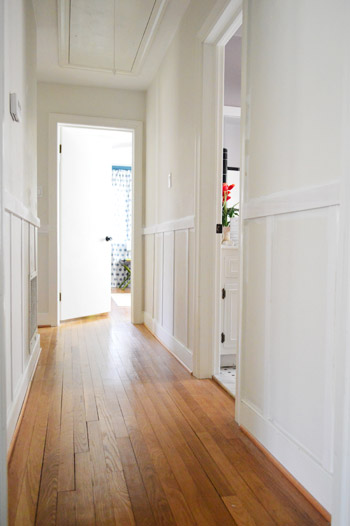
The next day it was finally time to paint the board and batten. We used Benjamin Moore Advance paint in Decorator’s White in a satin finish leftover from our office cabinet painting project. Advance paint is especially durable (we used it on our kitchen cabinets too) so we figured it was a good choice for hallway molding that might get its fair share of wear and tear.
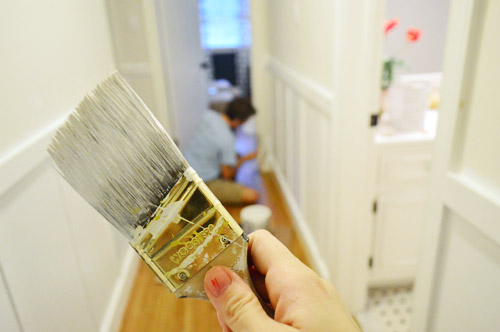
Admittedly, the finished picture of the painting step isn’t very dramatic since the walls above were still off-white.
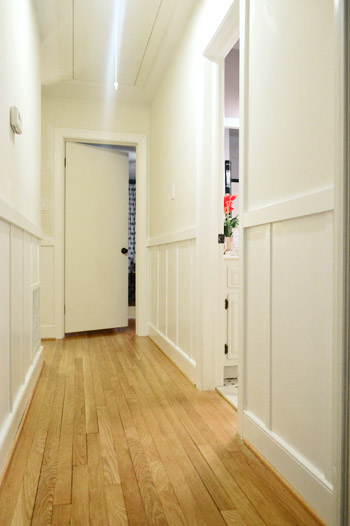
So after letting the paint cure for a couple of days we tackled painting the walls above the board and batten. Sherry was still nervous that taping the freshly-painted top rail could peel paint off, so she opted to cut in by hand around the top rails (you can read her tips for doing that here and watch the video in this post and the video here for even more tips). She did a great job, despite not having her usual short-handled brush handy.
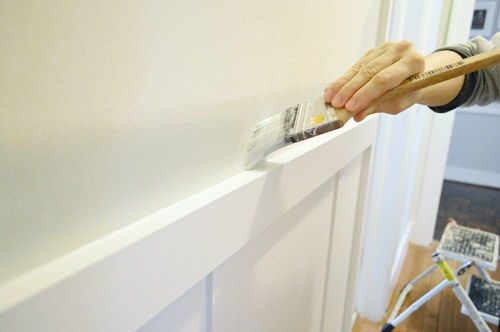
After she was done edging, I went back with the roller and (after a second coat) we had the finish line in sight.
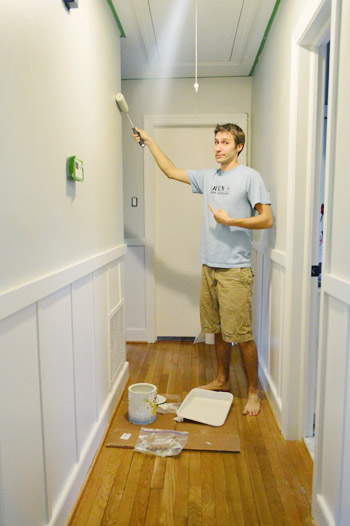
Oh, and if you couldn’t tell – we were painting the walls with Moonshine by Benjamin Moore since:
- we had some leftover from painting our dining room
- we didn’t want anything too bold/dark to close in the hallway
- it’s the color in the adjacent frame-filled hall and we wanted them to relate to each other (so things didn’t feel too choppy)
Note: we still have to paint the trim in the frame hallway the same white color as the board and batten.
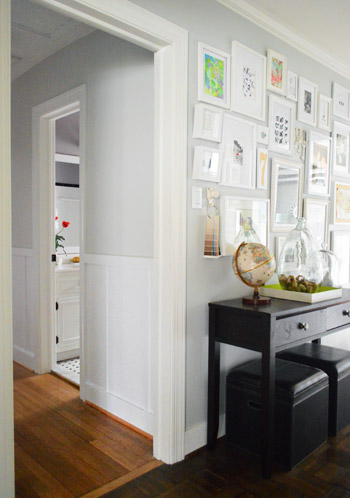
Boom. Just like that we’re ready for after pictures. So here we go!
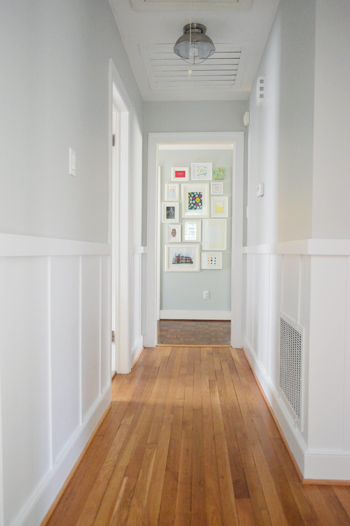
We’re in love with the result. And we’re kicking ourselves that we didn’t do it sooner. You know how you never quite realize how “blah” a space is until you do something to it and wonder why you waited so long? I mean, we walk through this hallway dozens of times a day and all we had done up to this point was hang some art in one small corner (the most hidden part of the hallway, ironically). But now that we’ve got the board and batten up we’re ready to hang some more.
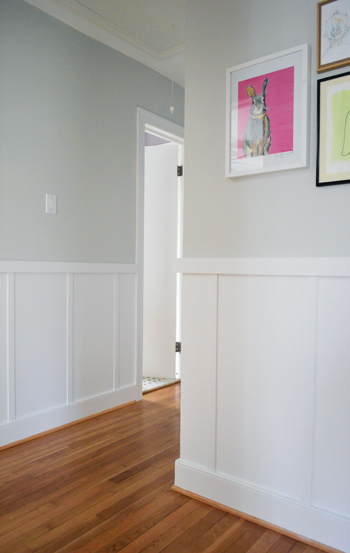
Total Project Cost
Okay, so let’s break down the budget. We only spent money on three items since we had things like paint, spackle, and caulk on hand. And had we actually purchased my nail gun back at my birthday in November as planned, our total cost for the project would’ve been only $57. Crazy, right?!
- Four 12′ pieces of lattice – $32 ($0.66/foot at Home Depot)
- Two 8′ pieces and two 6ft pieces of 1 x 3″ pine – $25 (also from Home Depot)
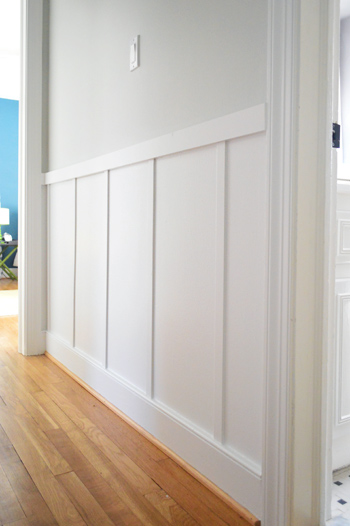
And time-wise, our project stretched over the course of five days (six if you count the trip to Home Depot for the materials). But if we had the luxury of not having to schedule things around Clara, it probably could’ve been completed in three days (first day for construction & spackling/caulking, second day for sanding/priming/painting the board and batten, third day for painting the wall). Heck, you could probably even ditch that third day if you’re doing this project on an already painted wall.
But if you’re doing the nailing by hand it might take longer (which explains why Sherry had the urge to make out with our nail gun). Oh but if you don’t want to buy one, you can always rent one from your local home improvement store, so that’s another option.
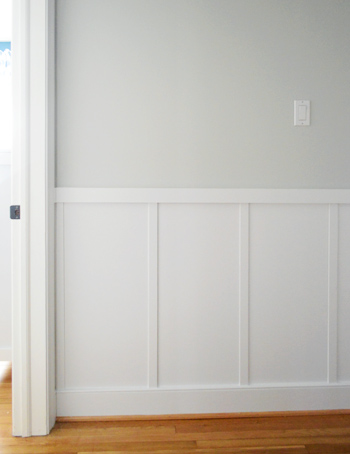
But here we are, roughly six days later and waaaay more excited to walk down our hallway. We’re now in the midst of figuring out what to hang on the walls above the board and batten, as well as choosing what next project we can take on to satisfy the itch I’ve now got on my nail gun trigger finger (after I wrestle it away from Sherry). I smell some crown molding in our future…
UPDATE: We repeated this project in our new house, but with a twist to make it feel a little bit fancier. Check out the tutorial for our new twist on classic board & batten here.
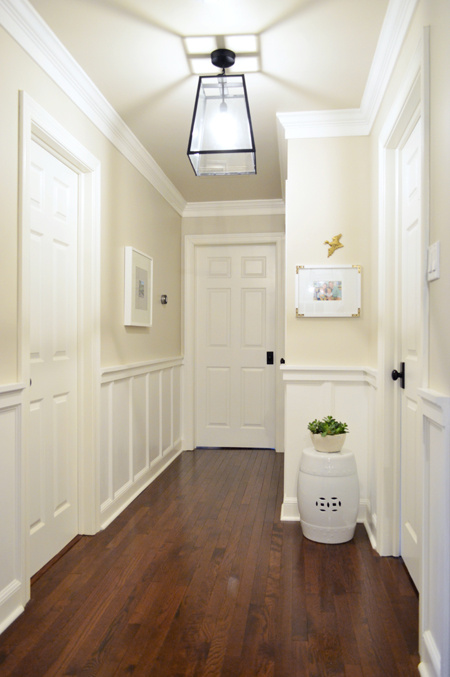
Update – Wanna know where we got something in our house or what paint colors we used? Just click on this button:


Cassondra says
We were planning to reuse some surprisingly nice kitchen wood paneling to do something similar in our hall, but this seems easier and not very expensive so maybe we’ll switch!
Hilary says
That looks so amazing! I’ve really wanted to do board and batten and this makes me want to even more! But I don’t think this house really has a room that it would work in. Boo :(
Tammy says
Looks great…I can’t wait to try this in my living room/dining room combo!
rachelle says
Do you think that style would work with more ornate baseboards?
YoungHouseLove says
I think it would, especially if you use a more ornate style molding or trim piece for the top rail (to go with the bottom rail). You can even bring home a few options and hold them up to see what looks best!
xo
s
Mary | lemongroveblog says
Fabulicous. Seriously – I absolutely love this! Can’t beat the bang for the back factor, either! :)
Johanna says
I love love love this tutorial. I have had wainscoting/board & baton envy for a long time and watching your tutorial made it seem SO do-able and way less scary than I imagined! Thanks for videoing it too, you guys are awesome. And the hallway looks fantastic, I love the dimension it adds! Are you eating dinner in the hallway tonight so you can just sit and swoon over its beauty? *virtual applause* :)
YoungHouseLove says
Haha, we should!
xo
s
Willow says
Love the whole project…now for the details! From the looks of the one pic I love the hall light fixture! Now you need a little subtle color on the attic pull. Perhaps an antique pull of some kind! Keep up the fun, love reading the blog!
YoungHouseLove says
Sounds like fun!
xo
s
Jan T says
It looks awesome you two! Wondering how you handled the outside corner with the top piece. Did you miter the corner or keep them flat? Great job!
YoungHouseLove says
We thought about mitering it but tried the overlapping thing instead and it looked great so we just did that and caulked and painted and it looks seamless! So there’s no miter saw necessary for this project!
xo
s
LARY@ Inspiration Nook says
They look amazing! Wish I could do this to our rental now :)
Kristin says
Sherry, I also have a love for pneumatic nailers. In fact, I’m quite sure the purchase of one may have saved our marriage when it came to the first project my husband and I ever used it for! Here it was, by the way… http://thetaleofstella.blogspot.com/2011/02/transformations.html
Board and batten looks fabulous!
YoungHouseLove says
Haha, I love it!
xo
s
Kelsey D. says
I just did board & batten in my bathroom, and I thought all the same things! This was so easy! Why didn’t I do this sooner?! My pictures aren’t doing it justice! I just want to sit on the toilet and stare at it all day! Great job :)
YoungHouseLove says
Haha, amen!
xo
s
Nikki Kelly says
Yay for pneumatic tools! An air compressor is one of the first tools that we purchased after buying our house. Installing hardwood floors kinda requires one. But my most favorite pneumatic tool yet is an HLVP paint sprayer. I love it soooooooo much. I recently painted an old dresser for my sister and to sand, prime and two coats of paint only took 4 hours. Best thing was that it looked perfect when I was done. So get one! It will change your life.
Nikki Kelly @ the ambitious procrastinator
YoungHouseLove says
Ooh, sounds awesome!
xo
s
Stephanie says
Nothing to add that everyone else has already said but so pretty!! That nail gun seems like it would be so handy to have for many other projects as well. Is it loud?
YoungHouseLove says
It’s not too bad. Just sounds like a clunk/biff (nail goes in, air puff comes out). You can hear it in the video :)
xo
s
mp says
Love it! I put up actual board in hubby’s bathroom (master bath) because he was hitting the walls with his wheelchair while getting to the toilet and protection/coverage was needed. Painted them a dark blue pulled out of the shower curtain.
Mary A says
Is the lattice wood smooth or rough?
YoungHouseLove says
It’s thankfully very smooth (not like lattice for outside, which is sort of furry).
xo
s
Hannah says
Holy Clark Kent, why doesn’t John wear glasses in every picture?
Now you have to make two precursory remarks—No, I’m not pregnant and No, John’s not wearing glasses in this post.
:) The board and battan makes the rabbit print look even more spectacular, I love it!
YoungHouseLove says
Hahaha!
xo
s
Katie S. says
Obsessed with how this turned out! This is going on our project list for sure. Also I’m in love with your hallway light. I’ve religiously followed your blog for 3 years and even refer to you 2 as regular household names (my hubby teases me about it) and must have totally missed the post about the light. Where did u get it? I want! :)
YoungHouseLove says
Ahh! We owe you an update on that! Soon I hope. We did it right before the board & batten but that was more pressing to get back to you guys about (since we were on the Pinterest Challenge deadline). Next week I promise the lighting info!
xo
s
Cara says
It looks great. Are you planning on a decorative air intake cover or just leaving it as is?
YoungHouseLove says
We’d love to upgrade that down the line!
xo
s
Pam says
I love this look and you make it look easy!
Can you mix heights? I have chair-rail installed in dining room and want to install B&B on the entry wall directly across from it at a higher level, about five feet up(I have 12 foot ceilings)
Thank you!
YoungHouseLove says
I would tape off a top rail (just using painter’s tape to mimic one) at that height and just step back and see if it looks good!
xo
s
Gabby says
Looks purty! ;)
How wide is your hallway? would love to try this out but afraid our dark and narrow looking hallway would be too small for this project. We also have rounded corners. HMMMMM…
Gabby
YoungHouseLove says
Ours is 40″ wide and we actually thinks it looks a bit wider thanks to the board & batten because the white is less enclosed feeling (sort of like how wide bands or stripes make things appear wider).
-John
farrah says
I love that you got a nail gun for your birthday! Now that s gift i could get behind.
Michele Daggar says
I love this. It’s great that you guys show things that aren’t expensive to do.
I just wanted to tell you that last night I was at the library with my daughter and I saw your book on the shelf and screamed “HEY IT’S THE YOUNG HOUSE LOVE BOOK …IN MY LIBRARY” quite loudly. Emily of course walked away in horror as most 12 year olds would do. I was so proud though, like you guys were part of the family. It made me smile.
YoungHouseLove says
Haha, that’s so sweet! Thanks so much for the library shout out. Haha!
xo
s
Lisa Wenckus says
I LOVE it! I have a hallway I really want to do this to! My question is, can I just use nail glue? Nail guns scare me!! (I am scared that I will not nail it the right way and split the wood…neither my husband nor I are DIYers…)
YoungHouseLove says
I’m not sure that would hold things strongly enough (maybe the battens, but not the rails). You could just manually use a hammer to bang in some nails though (takes longer, but you don’t need a nail gun).
xo
s
Jen says
Looks beautiful!
Emily says
Hi there! This might be a little off topic, but I was wondering what the height of your house ceiling is. Thanks! :)
YoungHouseLove says
They’re 8′ (standard height). Hope it helps!
xo
s
Graciela says
I love it!!!!
I will do it !!!!!!!
Thanks for your tips!!!
Gra
YoungHouseLove says
Good luck Gra!
xo,
s
Marian says
What an awesome project! The write up is so easy to follow. Can you hear compressors all over the place firing up and board and batten going up all over the country. Sears is gonna love you guys as nail guns sell out across America just in time for Mother’s Day.
And Sherry, I totally hear you on the beloved SHORT handled trim brush. Why do they make them all so long? I swear I’m gonna haul all my new ones over to my neighbor’s mitre saw and trim them up.
YoungHouseLove says
Hahah!
xo
s
Sara Silver says
I love, love this idea! It’s such a polished look and so easy to do! Thank you for posting…we too have an older home and our always looking for ways to update. Awesome post!
YoungHouseLove says
You’re welcome Sara! Good luck!
xo
s
John @ Our Home from Scratch says
Looks great and nice procedure. When we did our dining room wainscoting, I used MS Excel to plan out the entire layout. Made it much easier.
I’m happy to see you like your new brad nailer. They’re tough to live without once you start using them.
YoungHouseLove says
I can totally see that now! Haha! Who knows why we held out so long?!
xo
s
Reenie says
omg…..Clara’s comment, too cute!!! You guys did a fab job, love it.
Jesse says
I love it! Pretty easy and a major impact. I’m thinking of doing this in our house, thanks for the inspiration!
Chana says
Looks amazing. I love how it makes your hallway seem SOOO much more interesting. I’m just wondering, have you guys considered painting the shoe moulding? In some of the shots (like where it hits the doorway trim) it seems glaringly obvious? Or is that just me? Haha.
YoungHouseLove says
Shoe molding either blends with the floor or is painted to match the moldings, and in our case it’s not obvious in person (it’s the same color as the floor) and it stands up to scuffs and scrapes while hiding more dirt/dust/hair than white shoe molding does, so we appreciate it! We also wouldn’t just be working on this hallway since it’s stained throughout the house, so painting it would be a big job for something we don’t really notice in person :)
xo
s
Mingshu says
Did you need to do anything special for the our corner part where the two wall meet?
YoungHouseLove says
We didn’t even miter the corners since the rails looked great where the wood met. We caulked it a bit and then just primed and painted for a seamless look!
xo
s
AMK says
This is fantastic! Love it!
I tried filtering through the comments to see if someone else asked, but I didn’t notice…I am curious, why did you wait to paint the walls (top part) until after the bottom was done? Would it have been easier to paint the top, add all your boards, then paint the bottom? Then you couldn’t have to cut around your new board/batten? Just curious for future reference, if I decide to tackle this in our hallway oneday! :) Thanks for always coming up with GREAT projects!
YoungHouseLove says
Oh yes we mentioned that would have been even easier in the video, although after the installing and caulking we’d still have touch ups to do all around that edge.
xo,
s
Jennifer V says
Looks wonderful! Great job!
Erin says
I love this. Any advice on how you decided the right height?? I have some ugly/old wallpaper I am thinking of doing this to cover (only take down the top portion of paper) but I wonder if it will make the hallway look smaller? I see that the other tutorials take it much higher.
YoungHouseLove says
The standard height is around 36-40″ (around a third of the wall) but some folks take it higher and make it a coat hook area in a mudroom or a picture ledge in an entryway. I’d just hold up the rails and see what you like best :)
xo,
s
Bethany says
It looks great! You have pushed me over the edge for wanting some board and batten in my townhouse. I’m thinking it would be a great solution to add dimension in my two-story living room, but all my trim work is a cream color (I wish it wasn’t). All I’ve ever seen is white board and batten is white, so I wasn’t sure if a cream (or a darker color than the wall) would look right.
Tonya says
I love your laser level, but can’t read the brand. Do share? Do you love it?
I have been looking and looking for a sander that doesn’t kill my hand when I use. Sherry does that one work for you? I find the part you hold on to is just to big for my small hand.
Thanks
YoungHouseLove says
Yes, our sander is really great! The laser level is by black & decker too :)
xo,
s
Joe Hennessey says
Looks Really Cool! Hmmm Debating doing something like this in my hall but maybe funking it up a little with a bright colour
Ginny @ Goofy Monkeys says
I know I’m late in commenting on this but it looks fabulous! We’re planning a board & batten treatment in our basement when we finish it down the road. It’s an informal but interesting touch to a space. I love how it brightens it up a bit too.
And I’m happy for your nail gun purchase! It’s about time LOL! We’ve had one for the last 4 years or so and I’m always surprised at how often it gets used. My husband even uses the compresser to add air to the tires – there’s a little nozzle kit you can buy at Home Depot for that. Enjoy your new tools!
Katie says
Hi guys! Just wanted to thank you for this post. It is exactly what our hallway needs! We just painted it and I really wasn’t feeling the new walls but hated to go through the whole process (it involved homemade scaffolding over stairs) to repaint it. I think this is the perfect solution and it totally picked myself and my husband up and renewed our desire to keep renovating our house. Whew! Thanks!
Ian says
Lol! Nail guns are something aren’t they?
There is something about the sound and exhaust of air that does it for me. Wait till you ‘graduate’ to a framing nailer!
My big DeWALT is an absolute monster and using it, I am invincible :-)
Impressed with the no backboard, had me fooled!
Kate says
K, so.. I read your blog all the time and usually never comment.. I’m just not a commenty person, but OH MY GOODNESS! your hallway looks awesome now! I am floored! Or walled! Or whatever. Kudos to you guys!
Kaely says
This looks great. I love Board and Batten. Have you guys considered switching out the cover to your air return with something more decorative?
YoungHouseLove says
We originally planning to build or buy a more decorative cover but when we were done we were pretty impressed by how little it stood out to us visually, so I think we’re planning to leave it slone for now and put our money elsewhere.
-John
christine cooke says
Stumbled upon this and thought you might get a chuckle out of it.
http://the-canadian-housewife.blogspot.com/2013/02/dog-shaming.html
Christine
YoungHouseLove says
Ha! Burger could definitely use some shaming some days… :)
-John
Susan says
FanFreakinTastic! Love! $57.00 – Oh yeah!
Kristin says
This looks awesome! :)
Michelle says
Oh you guys… it looks awesome!!! I have been wanting to do this in our tiny laundry/mudroom. Tile goes down the end of this month and I think the board and batten will be after!!! So excited!!! And yes, a nailer like you bought is wonderful!! We have had ours for quite a while. They are oh so handy to have. :)
eleen marie says
I honestly didn’t think this would make such a huge difference! But, wow! Looks great w/ the paint color. Our new house luckily has board & batten in the 2nd (updated) bathroom & wainscoting in the family room. *swoon*
Rachel says
Wow…this looks so fantastic! I love your blog (and your book), and I’m always getting ideas from y’all.
Seeing as you two are big fans of Home Depot, I thought you may enjoy this little stand up about the store. My husband and I are huge Donald Glover fans, and we were laughing so hard over this! (warning: there is bad language, so maybe watch during naptime!)
http://www.comedycentral.com/video-clips/284qmk/stand-up-donald-glover–worst-place-on-earth
*I would recommend the entire stand up, too….but I knew you would appreciate the Home Depot portion of it :)
YoungHouseLove says
Ha! “Oooh, knobs!”
-John